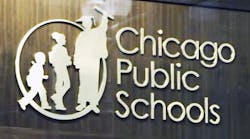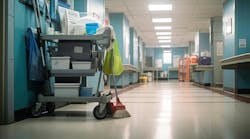Education administrators always are trying to get better performance from their custodial-services department. When schools use more efficient and cost-effective methods, administrators can focus on more pressing issues and worry less about routine problems. Some basics to consider:
-
Site safety inspections
A site safety inspection form can be developed for day custodians to complete and submit on a monthly basis. Documentation is important when addressing liability issues and will help the risk-management department. The categories documented should include common safety issues such as fire extinguishers, egress, electrical hazards, slip-and-fall concerns, flammable storage, regulatory matters (Material Safety Data Sheets (MSDS), personal protective equipment, body fluid spill materials, product labeling and chemical storage), emergency exits and lighting, playground safety, sanitation issues related to integrated pest management, and electric cart safety.
-
“Back-screen” criteria
Most institutions expect custodians to move heavy items such as boxes or furniture, lift mop buckets full of liquid, carry around 5-gallon pails of floor wax and more. It is important to work with human-resources representatives and healthcare providers to develop minimum physical standards, commonly known as “back-screen” criteria, for new staff. If a new hire cannot do the required work, it may invite on-the-job injuries. Take the time to train new employees carefully on lifting and back safety.
-
Quality control
Cleaning standards are the way to communicate the department's expectations of what is to be done each day to the custodial staff and create the baseline for cleaning quality inspections. Distribute the standards to staff as well, and they will help maintain quality control. Partner the standards with a regular, formal inspection program.
-
Chemical hazards
It is important to remove bleach, ammonia, strong acids and strong solvents from the custodial department. Take a look under the classroom sinks as well; it might be surprising to note the variety of chemicals being stored by teachers and other staff. There are safe and effective replacements for most strong chemicals. The EPA (www.epa.gov) or Green Seal (www.greenseal.org) websites are a good a place to start. Keep custodial closets locked to prevent student access, and make sure that custodial carts are not left unattended.
-
Glug … glug … glug
Eliminate hand-dilution of chemical cleaners, and use a chemical dispensing system or a pre-portioned system wherever possible. Eliminate the large packages, such as 5-gallon pails, which are heavy, hard to move around and difficult to pour.
-
Green cleaning
Educate the custodial staff on the use of green chemicals, supplies and green cleaning methods. A good source is the U.S. Green Building Council (www.usgbc.org). Green cleaning is the responsible thing to do in a school, where thousands of children spend hours.
-
Cleaning methods
At a minimum, make sure all custodians have up-to-date written work schedules. Also, make sure custodians are efficient by investing in modern and time-saving equipment such as backpack vacuums, autoscrubbers, trash carts and restroom-cleaning equipment. Modern cleaning methods such as team cleaning are another good area to investigate.
Try to be more creative about work schedules. Working a floor crew, for instance, on a regular weekend schedule will allow for more floor work, deep-cleaning activity or special cleaning projects, often with no students or staff around to worry about.
-
Staff recognition
Take time to think of more ways to acknowledge the custodial staff when they perform well, such as performance evaluations, award certificates, trophies, putting their photo in a newsletter, creating a custodial newsletter, scheduling a department picnic or awards ceremony, special hats, award pins, or t-shirts.
-
Regulatory compliance
It is time to get organized regarding regulations. The main two are OSHA's Bloodborne Pathogen Standard and Hazard Communication Standard. Annual training is required and should be fulfilled for both. Be sure to have Material Safety Data Sheet (MSDS) books fully updated and in place at all school sites.
Custodians and school staff should be able to have access at all times to these books and the Exposure Control Plan for Bloodborne Pathogens. Additional suggestions:
-
Train and orient all new custodians on these standards before they begin work.
-
Be sure to have body fluid spill materials and personal protective equipment in place at all times.
-
Make sure the main disinfectant on hand complies with the Bloodborne Pathogen Standard.
-
Train custodians to make sure mop water is placed down the sink drain into a sewage treatment plant, not out into the flower bed or street gutter where it ends up in a lake or other body of water.
-
Keep a folder for each employee with signed acknowledgement forms for all the training they receive, regulatory and otherwise.
-
-
Resilient floor care
Vinyl asbestos tile is gone, and some custodians miss it. Wear and tear on the new tile in classrooms can be mitigated in four ways:
-
Invest in carpet or felt snap-on glide protectors for classroom chairs, desks and tables.
-
Put enough floor finish on the floor to last until you plan to add more. A fully stripped floor can require three coats of sealer and six coats of finish in a school classroom to last from summer to summer. Also, custodians who strip floors too frequently can be wasting time and money. If custodians apply enough product to the floor in the first place, they will be able to deep scrub and re-coat (or even burnish), which is more cost-effective.
-
Evaluate the matting program. An 8-foot by 12-foot walkoff mat at all entry doors will keep a lot more dirt and sand out of a school than the small mats found at many schools.
-
Spend a little more when specifying and purchasing furniture, and insist on soft rollers for desk and computer chairs.
-
-
On-the-job injuries
Many ways exist to help prevent injuries and get workers back to their regular duties:
-
Train supervisors on worker-compensation issues and filling out the paperwork fully and correctly.
-
Provide the appropriate personal protective equipment and enforce its use. Let the MSDS be a guide.
-
Strive to accommodate work restrictions so that injured employees can come to work and be productive — within their restrictions — even if it is working at a desk job or for another department.
-
Establish a safety committee to review work injuries.
-
Take corrective action immediately to address needed changes in procedures, working conditions or other safety issues that will help prevent similar incidents.
-
-
General work rules
Formulate, update and distribute custodial work rules and policies. Custodians should sign a form that they have received the rules so no disagreements arise later.
Train supervisors on the progressive discipline procedure in your institution. Make the role and responsibility of the supervisors clear.
-
Departmental cooperation
Close cooperation with the school staff can only help the custodial-services department. A custodial representative should try one or more of the following:
-
Attend teacher meetings to get feedback on cleaning issues — find out their “hot” issues in advance.
-
Meet with the principals regularly and find out their cleaning priorities.
-
Teachers and students can be asked to help by recycling, placing chairs on top of desks at the end of the school day, or keeping their classrooms cleaner and easier to maintain.
-
If rooms are consistently hard to clean, ask the principal to talk to the teaching staff.
-
Attend PTA meetings; they might be interested in helping to buy a piece of cleaning equipment or volunteering to help on a special project.
-
-
Training, training, training
Establish training classes for custodians in the basics: classroom and restroom cleaning; infection control; electrical safety; as well as how to dust, vacuum, maintain equipment, clean windows, maintain a custodial closet, collect and remove trash, sweep and mop a floor, maintain a custodial cart, and all the items on the Site Safety Inspection Form.
Knopp is deputy director, facilities management department, custodial services division for the county of Riverside, Calif.

